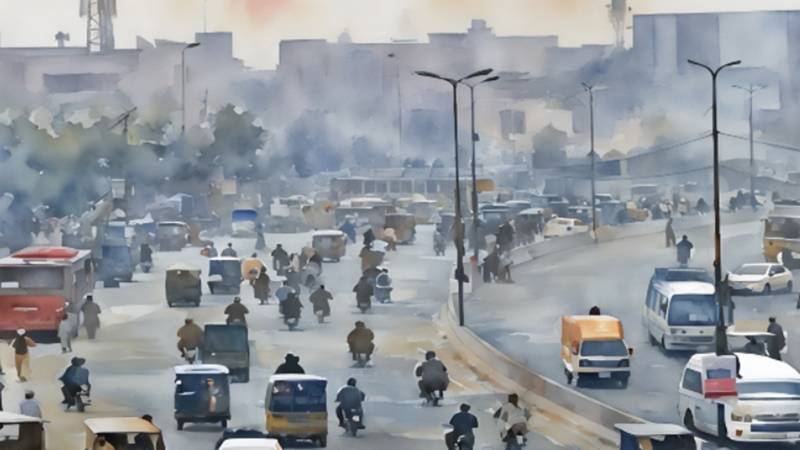
Lahore is in extreme distress as a city – once a hub of cultural prowess and historical splendour, is now in severe crisis as a result of defective and flawed urban planning. Lahore now presents a destructive landscape due to chaotic infrastructure with mismanaged developmental projects due to sudden urban sprawl. This poorly managed development has resulted in various issues, such as environmental degradation, diminishing capacity of underground water and other strained resources, and road and street congestion.
While the urban migration is a natural phenomenon, the way it is being handled seems like throwing things in a tough spot recklessly, ie without any care or consideration.
With each passing day, an increasing number of people continue to migrate to Lahore in search of better employment, education, healthcare, and residential opportunities. This surge in migration has spurred unplanned and rapid urban expansion, which has become a significant concern. The proliferation of new commercial and residential developments, undertaken without adequate attention to waste management, landfills, green spaces, and zoning regulations, has led to a noticeable decline in living standards. Consequently, Lahore has transitioned from a burgeoning metropolitan city into a polluted and overcrowded urban center, with an increasingly slum-like appearance.
This unregulated and unchecked growth has also resulted in the destruction of fertile agricultural land, replaced by sprawling concrete infrastructures. The swift construction of numerous housing schemes to accommodate the burgeoning population and urban migration has decimated green spaces, forests, and verdant pastures. This, in turn, has exacerbated the city’s rising temperatures, deteriorated air quality, and contributed to both the depletion and contamination of underground water reserves.
Addressing these pressing issues necessitates immediate intervention from development and planning authorities. Enforcing strict zoning regulations and investing in proper urban planning while safeguarding green spaces are critically important measures to enhance the quality of life for both Lahore’s long-time residents and its new arrivals.
Illegal and Unplanned Commercial Development
The proliferation of illegal and irregular residential and commercial projects has further compounded the challenges. These developments are undertaken without prior adjustments to the existing infrastructure, such as provisions for basic amenities to support the additional population and commercialisation. As a result, many new residents and structures are forced to rely on overstretched existing resources from the outset, leading to a further decline in the overall living standards for all residents.
Without immediate intervention, Lahore risks becoming an overwhelming cluster of buildings, pollution, garbage, and traffic congestion
There is a persistent practice of encroachment on residential areas, where residential buildings are converted into multistoried, multi-roomed hostels for students arriving from other cities. These constructions are carried out with utter disregard for the residences and families living in the vicinity. Not only does this cause overcrowding in these neighborhoods, but it also reduces property values and diminishes their appeal to potential future buyers. Furthermore, it places undue strain on the existing sewerage systems, transport networks, and water supply, as the original planning of these areas lacked the foresight to accommodate such developments.
Such irregular expansions only exacerbate the strain on the city’s already limited resources. This leads to frequent water and power shortages, compounded by congestion due to ill-conceived, haphazard constructions that pose significant risks for local residents. To address these issues, the concerned authorities must enforce strict regulations, impose penalties, and prioritize comprehensive urban planning strategies.
Environmental degradation
The deteriorating environmental conditions in Lahore are, in many ways, the result of destructive urban planning practices. Inefficient waste management has resulted in accumulating garbage, leading to widespread pollution. Untreated domestic and industrial sewage poses a grave threat to water bodies and, by extension, the entire ecosystem. The unchecked expansion of unplanned urbanization has also led to the “heat-island effect,” with a significant reduction in recreational spaces like parks, playgrounds, and lawns. Instead of lush greenery, the city is now dominated by clusters of buildings and plazas.
The skyline, once characterized by tall trees, is now obstructed by towering constructions, making it impossible to see the blue sky while traveling through the city. This unchecked urban sprawl is driven by the greed of developers eager to accumulate wealth through unplanned housing schemes. These ventures often uproot greenery and forests that stand in their way, leading to severe consequences such as imbalanced water tables, soil erosion, and a drastic decline in biodiversity—factors essential not only for forests but also for the ecological health of urban areas like Lahore.
Addressing these critical issues requires sustainable urban and town planning strategies. Illegal developments must be halted before construction even begins, ensuring that no new projects come at the expense of green spaces or fertile lands. Environmental stewardship must be entrusted to local citizens by raising awareness and encouraging them to alert authorities about such activities. Only developments that are compatible with the area and do not deplete existing resources should be permitted.
Social consequences of unchecked urban expansion
The social repercussions of inefficient and unplanned urban expansion are equally dire, manifesting in a significant decline in the quality of social life. The absence of safe public spaces contributes to higher crime rates and growing social unrest. Overcrowding further restricts opportunities for meaningful community interactions, leaving residents feeling alienated and disconnected. In such areas, people often prefer isolation to avoid discomfort, with many choosing to relocate to different neighborhoods, abandoning the comfort and familiarity of their surroundings. This disruption forces individuals and families to endure prolonged periods of adjustment as they seek peace and convenience elsewhere.
The widespread and multifaceted damage caused by unplanned, unchecked, irregular, and illegal commercialization schemes in Lahore calls for urgent attention and decisive action. Without immediate intervention, Lahore risks becoming an overwhelming cluster of buildings, pollution, garbage, and traffic congestion. Sustainable and expert-led development is essential to preserving the city’s historical, colorful, and vibrant character. The time to act is now, to restore Lahore’s former glory and ensure that its residents can once again take pride in and feel secure in their city.

